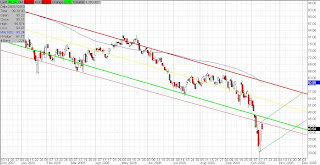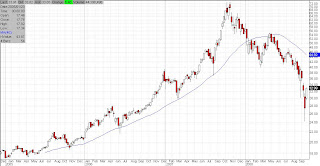
Click chart to enlarge
The above intraday chart of the Dow itself shows its nearly 500 point drop in the last 15 minutes of trading. This chart underscores what a casino Wall Street has become lately. There is no sense in trying to predict the market's next move, because odds are when it comes, it will not even have a catalyst.
We titled this post "maintaining sanity", because we feel that in times like this it is important to not let the market get the better of you. You should embrace the volatility and use it as a training tool to improve your trading. If you can navigate this market while remaining invested, the skills you learn will help you through any market conditions you may face in the future.
Learn this dance, and in time you'll be handsomely rewarded.
We can offer you 5 tips to help you maintain your sanity in this market:
1.) Avoid individual stocks. The main reason to do this is because it is psychologically easier to convince yourself to hold (and buy more of) an index during the really bad days than it is to convince yourself to hold(or buy more of) an individual stock. The index offers enough diversification that you don't have to doubt the future of the company you're invested in. With the stress this market brings to traders, one does not need the added stress of worrying about earnings reports, margins, etc.
2.) Don't buy your entire position at once. If you buy your entire position and the index goes against you, you are playing with scared money. Just at the time you should be adding to your position, instead you'll be frozen by fear because it has already moved so far against you. You always want to be in a position to add more if it goes against you, because if you do this repeatedly, you'll be able to break even or profit when the index eventually swings the other way.
3.) Always keep dry powder. The notion of getting all of your money in at the bottom is a fantasy. We would consider ourselves to be very successful if we were to get 70% of our money in near the bottom. The other 30% is an extremely valuable little insurance policy which makes it possible to cut your break even price in half if need be.
4.) Trade around your position. Scale in and out of your core position when the opportunity presents itself. Take small gains here and there as they present themselves. When you sell something, consider shorting it if it continues going higher. After all, you sold it because it just ran up. A further run is likely to fizzle out soon enough.
5.) Never lose sleep. If you're losing sleep over a trade, then you are trading outside your own comfort level. Everyone has a different tolerance for risk, and different investment goals. It is a very personal thing, and therefore all stock market advice should be taken with a grain of salt.
Don't listen to people like us. Make your own decisions and use CNBC, blogs, gurus as a way of gaining a net feel for the market rather than an "all or nothing" decisionmaker.
...
Right now, we remain focused on trying to get as much of our capital invested in the indexes at the bottom. While your basic premise may be different than ours, you may still benefit from our method of achieving this, because the same approach applies to scaling in and out of positions during a bull market. The skills this current market can teach you will stay with you for life.
To meet our aggressive goal, we sold 1/7th of our longs today, which was a sale of DDM at 35.5.
We put 3% of our account in FXP yesterday at 114.6. Neither price was particularly great, but the net effect gets us one step closer to our goal of remaining invested by trading around a core long position in a severly oversold market in order to benefit from the eventual and unpredictable rapid snap back.
We are now in a position where if the market goes up, we profit because we remain net long. We have 10 times the capital in long positions as we do shorts. If instead the market drops, we revisit the lows in much better shape than last time. By shedding 1/7th of our longs, we'll lose less on this ride down than last time. The FXP will also help our bottom line if we return to the lows. Both of these savings will mean more capital to invest at the bottom. Rinse and repeat.
You will not make major headway doing this. In fact, we have been on either side of 0% for quite some time. But on each return to the lows, we wind up there with more shares than last time. At some point, trading around our core position in such a way as to maximize the number of shares we hold, and to constantly be working to lower our net buy-in price will result in a formidable gain. The market's recent volatility is a welcome event if you can remain positive about what it can do for you, and take advantage of it rather than fight it.
We remain focused on selling DDM and SSO while adding FXP if the market rallies, and adding DDM and SSO while selling FXP only on a return to the lows. If the market breaks its recent lows, then the dry powder, the other 65% of our account, will come into play.
Let's hope tomorrow is just like today!
































